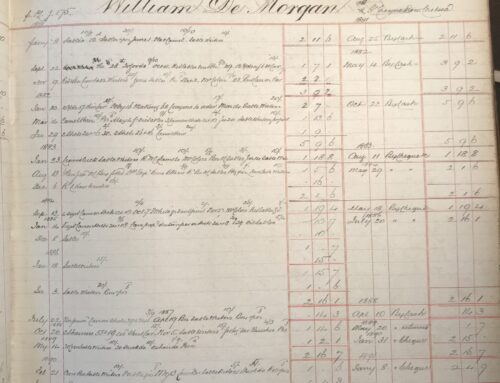This special spotlight display at the Watts Gallery brings together a remarkable selection of Evelyn De Morgan’s rare gold drawings, showcasing some of the most unique and innovative works from her career. Two of the of the 17 known gold drawings De Morgan created between 1880 and 1902 will go on display. Visitors will also have the chance to see preparatory pastel drawings for the figure of St. Francis, offering an intimate glimpse into De Morgan’s creative process and skill as a draftswoman.
Why Are These Drawings Special?
Unlike her preparatory sketches, which were typically made as studies for her oil paintings, De Morgan’s gold drawings are complete artworks, created as standalone pieces. These works allowed her to experiment with both composition and medium, highlighting her artistic talents while communicating her socio-political ideals. During her lifetime, De Morgan even sold these gold drawings as finished works, demonstrating their importance in her body of work.
What sets these drawings apart is their integration of gold pigment, a material De Morgan meticulously prepared by grinding dry cakes of gold pigment to create her own pastels and paints. This labour-intensive process gave the drawings a luminous quality that imbues them with life, warmth, and light. De Morgan’s interest in spiritualism and her belief in the writings of the mystic and alchemist Paracelsus, who saw gold as a colour of the highest spiritual order, further suggests that these drawings were deeply personal and carried significant meaning for the artist.
Themes and Symbolism
De Morgan’s gold drawings are imbued with themes of spirituality, mythology, and feminism—key elements of her broader artistic practice. Although she completed 102 oil paintings during her career, the compositions depicted in these gold drawings often duplicate those found in her oil works. This suggests that she worked on the gold pieces and the paintings simultaneously, particularly for compositions she felt most connected to.
Featuring figures such as angels, saints, biblical characters, and mythological deities, De Morgan’s gold drawings celebrate the superhuman, the divine, and the spiritual. Notably absent from these works are more earthbound subjects, such as her Pre-Raphaelite-style interiors, portraits, or any of her First World War paintings. This focus on ethereal, otherworldly figures suggests that De Morgan may have viewed these drawings as possessing talismanic qualities, perhaps offering protection or spiritual guidance.
Materials and Technique
Evelyn De Morgan’s technical skill and mastery of materials were rooted in her rigorous training at the Slade School of Art, where she excelled as a student and earned numerous awards. Throughout her career, she continued to work on paper, often creating sketches and studies in preparation for her oil paintings. Her mastery of materials is evident in the diversity of her sketches, which include pastel heads, chalk studies of nudes, and delicately rendered gestures.
The gold drawings, however, represent a different approach and purpose. De Morgan used gold pigment to create textured, decorative qualities in these works, giving them a rare and distinct visual effect. She purchased ‘cakes’ of gold pigment from Charles Roberson, a well-known colourman, and ground these into powder to create gouache paint and hard crayons. Her varied techniques, such as burnishing and rubbing the gold pigment into the paper, allowed her to achieve rich textures and luminous effects that enhance the depth of her compositions.
A Rare Opportunity
This display of St Francis and The Soul’s Prison House at Watts Gallery offers a rare opportunity to view Evelyn De Morgan’s gold drawings, which are unlike any other works from the Victorian period. Their combination of spiritual themes, innovative techniques, and use of luminous gold pigment makes them stand out as some of the most unique and personal pieces in De Morgan’s oeuvre.
The Marriage of St Francis and Holy Poverty
In 1875 De Morgan visited the Basilica of San Francesco d’Assisi on a trip to Italy. The interior walls are decorated with murals by the early Renaissance painter Giotto depicting the life of St Francis. De Morgan was particularly inspired by his allegorical fresco “St Francis Marrying Holy Poverty” which shows the moment that St Francis rejects materialism to fully devote himself to his faith.
Her application of the gold paint echoes the fresco painting she was inspired by. Fresco is the method of applying wet pigment to freshly applied plaster on walls. It requires the artist to paint with short brushstrokes in the same direction to build up the image. De Morgan has applied the gold pigment and black chalk with a similar approach in this work, particularly evident in the drapery.

The Soul’s Prison House
A bold flash of pure white strikes horizontally through this composition. It is a scroll containing the word of St Augustine of Hippo and dominates the foreground against the gold figure. It is held by a captive young woman in a dank prison and yet the gold colour means that she radiates through the gloom.
St Augustine believed the grace of Christ was indispensable to human freedom. De Morgan’s use of gold in this drawing allows her to convey her belief that eternal salvation could only come to those who had spiritual and moral conviction on earth. In this scene we witness the awakening of a soul and the realisation of its earthly entrapment. The white scroll is visually striking and contrasts dramatically with the dark chalk trees blowing in the wind beyond the window. Through her limited palette De Morgan has created depth and interest in this composition and forced us to focus on the importance of turning to faith in times of despair.

Be sure to visit the Watts Gallery this weekend to experience the beauty, depth, and spirituality of Evelyn De Morgan’s gold drawings in this extraordinary spotlight display. These works provide not only a glimpse into De Morgan’s artistic process but also an intimate look at her philosophical beliefs and her desire to communicate universal truths through her art.






